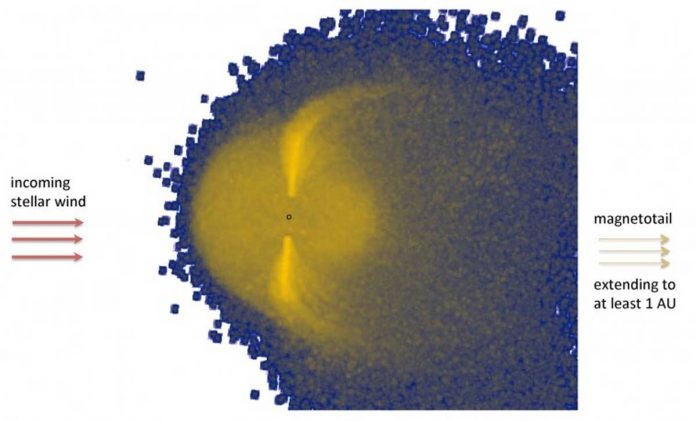Scientists have found out the first signature of a magnetic field. This magnetic field is surrounding a planet outside of our solar system. Earth has a magnetic field too which acts as a shield against energetic particles from the sun which we call solar wind. Scientists think magnetic field around other planets plays a similar role.
An international team of astronomers have analysed the data from Hubble Space Telescope and found out that the signature of a magnetic field in a planet outside our solar system. The findings of the research have been published in the journal Nature Astronomy. This was the first time such a feature has been witnessed on an exoplanet.
A magnetic field describes the observations of an extended region of charged carbon particles. This surrounds a planet and stream away from it in a long tail. Magnetic fields are very important to protect planetary atmospheres. So, the identification of magnetic fields in exoplanets is a significant step in order to understand what these alien worlds may look like.
The team of astronomer have observed the exoplanet HAT-P-11b with the help of Hubble. HAT-P-11b is a Neptune-sized planet and it is 123 light-years from Earth. This planet passes directly across its host star six times in a “transit.” The team have made these observations in the ultraviolet light spectrum to see what the human eyes cannot see.
Hubble has detected carbon ions which is a charged particles that interact with magnetic fields. This was surrounding the planet and this is called magnetosphere. Magnetosphere is a region around a planet and it is formed by the object’s interaction with the solar wind emitted by its host star.
Gilda Ballester, an adjunct research professor at the University of Arizona Lunar and Planetary Laboratory and a co-author of the research paper, said that for the first time the signature of an exoplanet’s magnetic field has been directly detected on a planet which is not in our own solar system. Earth’s magnetic field is strong and protects its atmosphere and surface from direct bombardment of the energetic particles of solar wind.
HAT-P-11b’s magnetosphere will lead the astronomers to understand better about the habitability of an exoplanet. As not all planets and moons in our solar system have magnetic fields of their own. So, the connection between magnetic fields and a planet’s habitability needs in depth study.
Ballester also added that HAT-P-11 b is a very exciting target for astronomers. As Hubble’s UV transit observations have revealed a magnetosphere around HAT-P-11. Astronomers have seen an extended ion component and a long tail of escaping ions around the planet. According to astronomers this general method can detect magnetospheres around exoplanets and assess their role in potential habitability.
Ballester has observed HAT-P-11b and selected this planet as a specific target for UV studies. Ballester discovered carbon ions in the region surrounding the planet and as well as extending in a long tail that streamed away from the planet. Its speed was 100,000 mph.
Lead-author of the research paper Lotfi Ben-Jaffel has used 3D computer simulations. With this the team have created model interactions between the planet’s uppermost atmospheric regions and magnetic field with the incoming solar wind.
Ballester explained, “Just like Earth’s magnetic field and its immediate space environment interact with the impinging solar wind, which consists of charged particles traveling at about 900,000 mph, there are interactions between HAT-P-11b’s magnetic field and its immediate space environment with the solar wind from its host star, and those are very complex”.
The magnetospheres of Earth and HAT-P-11b are the same. But HAT-P-11b is too close to its host star. This is why the upper atmosphere of HAT-P-11b is warm. The atmosphere “boil off” into space and form magnetotail.
the metallicity of HAT-P-11b’s atmosphere which is chemical elements in an object that are heavier than hydrogen and helium, is lower than expected. In our solar system, Neptune and Uranus are the icy gas planets and both are rich in metals but have weak magnetic fields. Jupiter and Saturn are larger gas planets and have low metallicity and strong magnetic fields. HAT-P-11b has low atmospheric metallicity which challenges current models of exoplanet formation.
Ballester said that HAT-P-11b’s mass is only 8% of that of Jupiter. The atmospheric composition of HAT-P-11b suggests that further work needs to be done to develop current theories of how certain exoplanets form in general.
The Hubble Space Telescope is a project of NASA and the European Space Agency.

